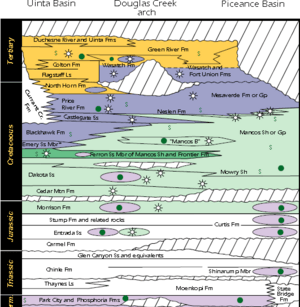Mancos Shale facts for kids
Quick facts for kids Mancos ShaleStratigraphic range: Mid Albian-Campanian ~110–80Ma |
|
|---|---|

Mancos Shale badlands in Capitol Reef National Park, southern Utah.
|
|
| Type | Geologic formation |
| Sub-units | See text |
| Underlies | Mesaverde Formation |
| Overlies | Dakota Group |
| Lithology | |
| Primary | Shale |
| Location | |
| Coordinates | 37°21′09″N 108°17′49″W / 37.3525426°N 108.2969254°W |
| Region | Arizona, Colorado, New Mexico, Utah, Wyoming |
| Country | |
| Extent | Basin and Range, Colorado Plateau & San Juan Mountains Provinces |
| Type section | |
| Named for | Mancos, Colorado |

The Mancos Shale or Mancos Group is a Late Cretaceous (Upper Cretaceous) geologic formation of the Western United States.
The Mancos Shale was first described by Cross and Purington in 1899 and was named for exposures near the town of Mancos, Colorado.
Geology
It is dominated by mudrock that accumulated in offshore and marine environments of the Cretaceous North American Inland Sea. The Mancos was deposited during the Cenomanian (locally Albian) through Campanian ages, approximately from 95 Ma to 80 Ma.
Stratigraphically the Mancos Shale fills the interval between the Dakota Group and the Mesaverde Formation Group.
The Mancos Shale rests conformably on the Dakota and in its upper part grades into and intertongues with the Mesaverde Group. The shale tongues typically have sharp basal contacts and gradational upper contacts.
The classification broadly corresponds with the Colorado Group classification of the Great Plains region; as such, various units of the Colorado Group are recognized within the Mancos in those areas where their distinct facies can be recognized.
Occurrences
The Mancos occurs in the Basin and Range Province, the Colorado Plateau Province, and the San Juan Mountains Province.
Structural basins
It also occurs in the following structural basins:
|
|
Subunits
The Mancos occurs with the following subunit names (listed alphabetically): (bold: principle reference section at the type location)
|
|
|
Images for kids
-
Mancos Shale badlands in Capitol Reef National Park, southern Utah.



